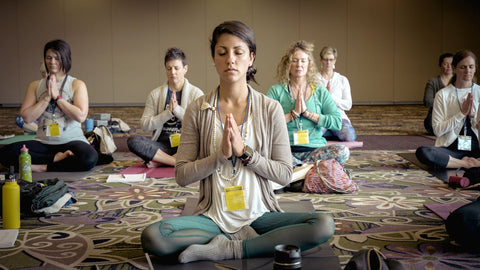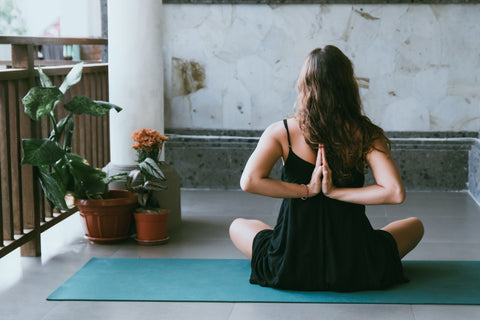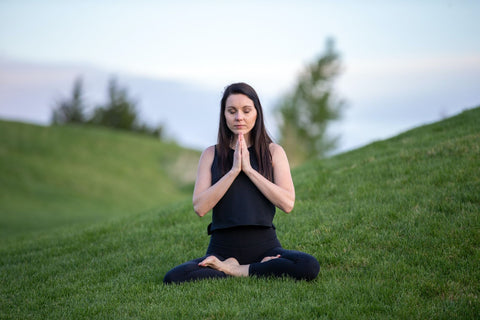Yoga asanas have existed since at least circa 3,300 B.C. So, for over 5,000 years, yoga positions and yoga philosophy have been practiced to reach a state of mind/body unity. The reason for this isn’t a secret— yoga has always been practiced to reach a meditative state where the mind goes within, seeks inner knowledge and ultimately brings calm.
The never-ending questions and thoughts that run through our minds aren’t new to the human experience. On the contrary, it is part of the human experience. Yoga and meditation have been used for thousands of years of time to calm the mind, which also calms heart rate and blood pressure. Can this same tactic be used to help anxiety and depression?

Understanding yoga
In my experience, the results of yoga outweigh the actual “doing” of the postures. I find that when I am not keeping up with my practice I get more mind chatter or “monkey mind.” I now do yoga to keep my mind and body in balance and, having struggled with anxiety and panic attacks myself, I get anxious when I skip my own yoga for stress relief practice.
Yoga can be a physical challenge, but the mental challenge is much more powerful. You may have heard teachers say that savasana, or “corpse pose,” is the hardest posture because the aim is to be in a completely relaxed state. Have you ever laid there thinking “when will this be over?” Or, maybe you’ve noticed some folks run out of the class before this ending pose to get on with their busy day. If you’re one of the students who skips savasana, next time don’t. There is a reason that this pose is at the end of the practice.

Everything that you have practiced during your one hour yoga class leads to the ability of being still and in this meditative state of savasana. Most likely, it’s harder than you expected and if you practice meditation, which I highly recommend, you can understand how the mind takes some time to settle. This same concept goes for the body. The purpose of your entire yoga class is to relax your body enough so you can engage in a meditative state, even if it’s just for five minutes. Practicing the asanas helps the settling of the mind, which allows the time and space for relaxation.
Yoga for Anxiety and Depression
We know that stress is one of the leading culprits of anxiety and depression. One major function of yoga is breathing or “pranayama.” Learning and engaging in breathing techniques can immediately calm the body, which can help relieve stress, anxiety and depression.
The immediate response when the mind and body are under severe stress is to raise the heart rate. Instead of tensing under stress, we want to achieve a relaxing response. If you struggle with anxiety or depression, this may sound impossible, but it really all comes down to taking control of your breathing pattern. Having the ability to moderate your breathing will calm you down by sending a message to the body and brain to relax.

Practicing pranayama
The next time you feel anxious, depressed or stressed out, try sitting in a comfortable position and focusing on your breath. Inhale deeply for seven seconds, then exhale for another seven seconds. After your exhalation, immediately inhale—slowly and deeply— for nine seconds, then exhale on the same count. Move onto 11 then 13 seconds, and then work your way backwards down to seven again. Continue to breathe deeply, focusing on your inhalation and exhalation, letting any thoughts that come into your mind drift away.
This short breathing exercise will focus your mind on your breath and will allow you to let go of the worries of the world, at least temporarily. As you focus on your breath, your heart rate will start to decrease, your blood pressure will drop and you will gain mental clarity. Of course, the key is to do this exercise before having a panic attack or allowing yourself to get into that place of anxiety or depression. To enhance your meditation practice, try setting up a meditation space in your house where you can create a sacred environment of comfort that invites this relaxing state.

Practicing yoga at home with these breathing techniques will strengthen the ability to help ease the mind and nervous system in times of depression or anxiety. Even if I am unable to practice yoga positions due to injuries, I still practice breathing methods and meditation, which are both part of yoga.
It is important to be aware of your body and its reaction to certain situations. If you are familiar with the signs of stress in your body, then you can nip it in the bud and catch yourself before an attack occurs. The key to avoiding moments of anxiety and depression is to stay in the present. If we focus too much on the future, we’re anxious. If we focus too much on the past, we’re depressed. Practicing yoga and meditation strengthens this ability to stay in the present, which prevents your mind from wandering to parts unknown.
The practice of yoga can save you from unneeded stress, anxiety and depression. Even practicing for as little as five minutes a day can bring huge benefits into your life. Making this time for you is a commitment to your own well being and, just in case you need a reminder, it’s never too late to give yourself a little love.
About the Author
Elizabeth started yoga 20 years ago because of severe and chronic back injuries. Yoga has been the main healing factor that has improved her life and has led her to being a certified teacher in Vinyasa, Hatha, Yin and Restorative Yoga. She is also owner of Embrace Yoga Marin in San Rafael, California.







